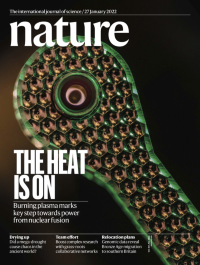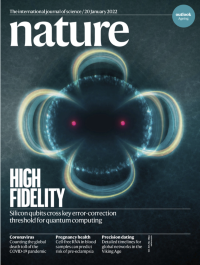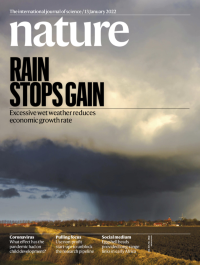Volume 601
-
No. 7894 27 January 2022
The heat is onA key requirement for self-sustaining energy generation using nuclear fusion is for the plasma in which the fusion occurs to be heated by the fusion reactions themselves. In this week’s issue, Alex Zylstra and his colleagues demonstrate a ‘burning plasma’ regime in which fusion reactions are the primary source of heat that sustains the plasma. Working at the National Ignition Facility at Lawrence Livermore National Laboratory in California, the researchers used 192 lasers to create a plasma of deuterium and tritium. By optimizing the experimental set-up the team was able to create conditions under which the plasma became self-heating — a key step towards making nuclear fusion a viable power source. The cover shows one of the ‘targets’ used by the team to create a burning plasma. The deuterium–tritium fuel capsule is visible in circular window at the centre. When irradiated by the laser beams, the target capsule melts and implodes, starting the fusion reaction.
-
No. 7893 20 January 2022
High fidelityThe cover image shows an artist’s impression of spin qubits, the building blocks of a silicon quantum computer. The two red spheres are atomic nuclei surrounded by the wavefunction of an associated electron (the ellipse). The four ‘lobes’ represent entanglement between the qubits. In this week’s issue, three papers independently present silicon-based quantum-computing platforms that used multiqubit entanglement: one, from Andrea Morello and colleagues, relies on atoms implanted in silicon (shown), the other two, from Lieven Vandersypen and Seigo Tarucha and their respective co-workers, work with electrons in quantum dots. Crucially, all three systems have achieved fidelity in excess of 99%, which means that errors occur less than once every 100 operations. This is a key threshold for error correction that could make quantum computers based on silicon qubits a viable proposition — one that could make ready use of long-established chip manufacturing technologies.
Nature Outlook
-
No. 7892 13 January 2022
Rain stops gainThe cover shows heavy storms over Ostfriesland in Germany. In general, economic assessments of the effects of climate change do not include daily rainfall. In this week’s issue, Leonie Wenz and her colleagues show that economic growth rates are reduced by increases in the number of wet days and in extreme daily rainfall. The researchers analysed a global panel of subnational economic output for 1,554 regions worldwide over the past 40 years. They also found that high-income nations and the services and manufacturing sectors were most hindered by daily rainfall. They suggest that increased extreme rainfall driven by climate change will have a detrimental effect on the global economy.
-
No. 7891 6 January 2022
Field guideThe cover shows the structure of the interstellar magnetic field overlaid on the Taurus molecular cloud. During star formation, the interstellar magnetic field dissipates and molecular clouds collapse under their own gravity, eventually forming stars. But measuring the strength of the interstellar magnetic field is very difficult. In this week’s issue, Tao-Chung Ching and his colleagues present observations of the magnetic field of the Taurus molecular cloud. The researchers were able to determine that the magnetic field has an ordered structure throughout a region called the cold neutral medium, as well as the molecular envelope and dense core, suggesting that molecular clouds are primed for collapse earlier than was typically assumed.




